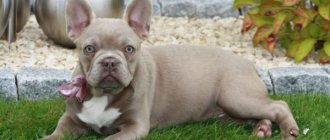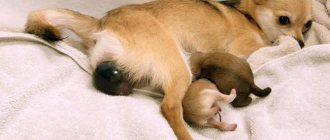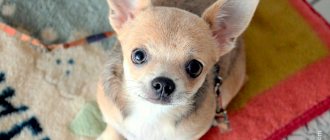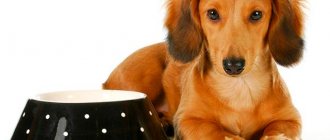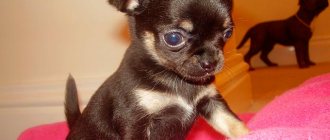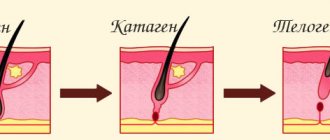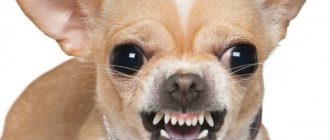In this article I will talk about the birth of Chihuahua dogs. This is a difficult process for the female, which must be completed with the help of the owner. Therefore, you should know how long pregnancy lasts, what are the signs of impending birth, how to prepare for this and help your pet. I will consider the rules for caring for Chihuahua and mixed-breed babies and suggest the most original nicknames. I will present in the table what the growth standard of the cubs is by month.
At what age to knit
A male dog is allowed for breeding for the first time when he is one year old. The girl should be at least one and a half years old by this time.
With this approach, the female will have six to seven litters throughout her life if annual whelping is planned. Earlier mating for a bitch is undesirable, as the risk of intrauterine developmental disorders increases. Premature or complicated labor may occur.
Late mating (after three years) is dangerous for a girl, since the elasticity of the genitals is lost.
Individuals allowed to mate must be healthy, treated for parasites, and vaccinated. Dog owners must agree on the place of mating, study the documents and pedigrees of both individuals in advance.
Stages of pregnancy by day
The duration of gestation for Chihuahuas is 56-72 days. It is not possible to immediately notice the dog’s new position. During normal course, the behavior remains virtually unchanged. Obvious signs appear later.
The average duration of pregnancy and its main stages are shown in the table.
| Deadline by days | Changes |
| 1-7 | After successful fertilization of the egg, the result is the formation of a zygote. A clear fluid without an unpleasant odor may leak from the vagina |
| 8-14 | Cell division occurs and embryos descend into the uterus |
| 15-21 | The nascent fruits are implanted into the mucous membranes, through which they receive the necessary nutrients. The female's nipples become enlarged and her appetite decreases |
| 22-28 | With gentle palpation, which can only be practiced by an experienced dog breeder or veterinarian, the embryos are felt. Their spine, muzzle, and eyes are already forming. The bitch's nipples swell, her belly begins to grow rapidly, and toxicosis may appear. |
| 29-35 | The developing fruits develop fingers, claws, and intimate organs. The dog's weight increases. You can do an ultrasound to determine gender and number |
| 36-42 | The female's belly acquires an impressive size, her nipples darken. It is necessary to move her to a house prepared for childbirth |
| 43-49 | The irritability of the Chihuahua becomes characteristic. Hair falls out on the belly. At this stage, it is advisable to reduce the time of walking and moderate physical activity. It is recommended to reduce the amount of calcium-containing foods in your diet. |
| 50-57 | Monitoring is intensified, since at this stage, with multiple pregnancies or the development of large puppies, labor may begin. The temperature is measured daily; if it is below 37 degrees, whelping may occur in the near future. The bitch produces colostrum |
| 58-72 | The final stage is coming. The dog is worried and tries to retire. She has virtually no appetite and produces colostrum from her nipples. Everything needs to be prepared for childbirth |
In a Chihuahua, pregnancy lasts 72 days; during this period, constant monitoring of her condition is recommended in order to provide the necessary assistance in a timely manner.
What does temperature mean?
Body temperature is used to judge the number of days remaining before birth. Based on the obtained indicators, they can determine how long pregnant Chihuahuas walk and when the puppies will be born. During pregnancy, dogs experience 38 or 39o. This is the normal temperature for bearing offspring. But a week before giving birth, the temperature begins to change. A day before the birth of the puppies, it drops to 36o, and after birth it returns to normal.
Why do the test?
A pregnancy test is done through a blood draw. Laboratory testing determines the presence of relaxin. The placenta is responsible for the production of this hormone. She begins to produce it 15 days after the fertilized egg attaches to the wall of the uterus. By the fourth week of pregnancy, relaxin increases sharply and remains at this level until the dog gives birth. If relaxin is elevated, it means the Chihuahua is in an “interesting position.” The accuracy of the result is 99%.
note
! The test for the presence of relaxin is the only reliable diagnostic test that confirms the success of the mating and excludes false pregnancy.
Why do an ultrasound?
Thanks to an ultrasound performed after 40 days from the moment of conception, you will learn about the number of future puppies. Most often, dogs of this breed have a singleton pregnancy. During a multiple pregnancy, a Chihuahua can bear from 2 to 4 puppies weighing no more than 100 g. An ultrasound can tell you the number of puppies in the litter, their mobility and heartbeat.
Special food
From the fourth week after mating, they begin to increase the daily ration by 2% every 7 days.
If the dog is accustomed to commercial food, then when the gestation period reaches one month, it is transferred to specialized varieties aimed at females bearing offspring. They completely provide the body with the necessary elements.
With a natural menu, increase the amount of kefir, cottage cheese, fruits and vegetables, since the development of fruits requires more calcium, proteins, and various vitamins.
Carrots and buckwheat porridge are also useful for the female. Egg yolk is given weekly. They practice four meals a day. At the same time, make sure that the dog does not overeat.
Expert opinion
Anna Abramenko
An avid dog lover. Experience in veterinary medicine since 2009.
Ask a Question
Approximately 14 days before giving birth, the percentage of foods with a high concentration of calcium and protein in the diet is reduced.
7 days before the expected birth, rice or buckwheat porridge is boiled in water. Add a little butter. They give a mixture of crushed walnuts with grated raisins and dried apricots, and apple pieces. Recommended vegetables include zucchini, pumpkin, and boiled cauliflower. They make balls of rolled oats with cottage cheese.
When drawing up a weekly menu at all stages of pregnancy, you should consult with an experienced veterinarian. He will recommend vitamin and mineral supplements.
First vaccination schedule for dogs
From the age of 2 months, pets begin to be vaccinated against major diseases. To do this, contact a veterinarian who will help you draw up a vaccination schedule.
All main vaccines are combined, that is, puppies are vaccinated against several diseases at one time.
7-10 days before each vaccination, the dog is wormed.
For this, anthelmintic drugs with o. For example, Drontal. The dosage and rules of use are according to the instructions.
Before vaccination, a veterinarian examination is required.
Approximate vaccination calendar
| Name of the disease | First vaccination age in weeks | Second vaccination age in weeks | Revaccination age in weeks |
| Plague | 8-10 | 21-28 | 1 year |
| Infectious hepatitis | 8-10 | 21-28 | 1 year |
| Parvovirus enteritis | 8-10 | 21-28 | 1 year |
| Parainfluenza | 8-10 | 21-28 | 1 year |
| Leptospirosis | 8-10 | 21-28 | 1 year |
| Rabies | 12-13 | — | 1 year |
| Trichophytosis | 4-24 | 10-14 | 1 year |
| Microsporia | 4-24 | 10-14 | 1 year |
Subsequently, the dog is vaccinated every year.
After vaccination, the animal is lethargic for 1-2 days.
One-time vomiting or diarrhea, one-time refusal to eat are allowed. A pea-sized lump appears at the injection site, which resolves within 2 weeks to 2 months.
Complications after vaccination develop extremely rarely.
More often when vaccinating a sick animal, using an expired or improperly stored vaccine.
Be sure to get your pets vaccinated
Signs:
- increased body temperature more than 39 °C;
- repeated vomiting and diarrhea;
- increased lethargy and weakness;
- profuse drooling;
- labored breathing;
- complete refusal to eat.
In all these cases, call the veterinarian immediately; you cannot do anything on your own.
Preparing the site
If a small Chihuahua is supposed to give birth in natural home conditions, then it is important to choose a suitable corner where strangers will not appear and unnecessary noise is eliminated.
It is advisable for the mother in labor to allocate a shady separate room.
The box in which the birth is planned can be purchased at a pet store. If necessary, it is easy to make it yourself.
Expert opinion
Anna Abramenko
An avid dog lover. Experience in veterinary medicine since 2009.
Ask a Question
The birthing house should be cramped so that the dog has the opportunity to rest his paws on the walls during the whelping process. Therefore, the material selected is dense, durable, and well polished.
Install the box away from heating appliances so as to prevent drafts. The passage to it is left free. About half a month before giving birth, the female is moved into it, giving the opportunity to adapt and get used to this place. Two weeks before the permit, fresh oilcloth is laid in the box, and a soft diaper is spread on it.
It is advisable to make two houses so that it is possible to relocate newborns. The front wall is made removable. This device makes cleaning and caring for puppies easier. Place a mattress and a heating pad.
Can a dog give birth on its own?
Only a small proportion of Chihuahua owners place their pets in a clinic for delivery. This is done for medical reasons. When everything is in order with the dog, it is able to give birth on its own without human intervention, but under his supervision.
Giving birth to a dog at home is quite common; it proceeds easily and without outside help if the Chihuahua meets several criteria:
- The woman in labor weighs at least 1.8-2 kg.
- Her age is from 1.5 to 4 years.
- There are no health contraindications.
If a Chihuahua does not meet at least one of the criteria, the likelihood of complications during childbirth and pathological abnormalities in the development of puppies increases.
To ensure everything goes smoothly, a pregnant Chihuahua needs to be seen at a veterinary clinic. The doctor will assess the condition and readiness of the dog to give birth on its own and give the necessary recommendations to the breeder. If a natural birth is not possible, a caesarean section is performed in the clinic.
When Chihuahuas give birth on their own, you need to create an environment of calm and safety at home. The bitch’s labor needs to be monitored from a short distance, and if necessary, be ready to react and help without fuss.
What you will need during childbirth
In order to correctly carry out all the manipulations to relieve the burden of a Chihuahua, prepare equipment, necessary items, and medications in advance, such as:
- electric heater;
- room thermometer;
- thermometer;
- oilcloth;
- towels;
- diapers;
- tweezers;
- basin for contaminated items;
- disinfected scissors;
- sterile gauze wipes and cotton wool;
- syringes;
- silk threads treated with a disinfecting solution for tying the umbilical cord;
- medical alcohol;
- scales.
To record the onset of labor, as well as the time of birth of the puppies, you will need pens, a notebook, and a watch.
Signs of approach
To understand whether a Chihuahua’s due date is approaching or not, pay attention to the dog’s behavior.
- She begins to worry and fuss. If a secluded box has not been prepared for her in advance, she will look for such a place on her own. In the shelter prepared for whelping, the bitch rummages among the laid diapers, making a comfortable nest for herself.
- Some pregnant dogs begin to thrash around in their final stages. They experience rapid heartbeat, trembling, heavy breathing, and whitish discharge. Droplets of colostrum flow from the swollen nipples. The stomach drops noticeably.
- The temperature before childbirth drops to 37 degrees and below. This indicator indicates that there is no more than a day left before the puppies appear.
Chihuahua character
Chihuahua with his owner
Chihuahua is a little philosopher who has absorbed the wisdom of his ancient ancestors, learned to understand and accept life in all its manifestations. These kids are distinguished from other dwarf breeds by their calmness and balance: they do not become hysterical over any trivial matter and do not shake from excess emotions in a feverish “chill.” Adults behave seriously and a little arrogantly, which does not at all fit with their “pocket” dimensions. In general, Chihuahuas are very similar to people: each animal has a whole set of unique character traits that make it unlike other members of its own kind.
Representatives of this breed are very proud, so they respond to disrespectful attitudes with cold contempt. These “Mexican amigos” adore their own owners to the point of madness. Whatever the dog does in the presence of the owner, it does it with only one purpose - to gain his approval. Passionate love for the owner is accompanied by no less strong jealousy. To verify the veracity of this statement, it is enough to pet or treat another dog in front of your pet.
Cool dogs
Chihuahuas are very smart, quickly recognizing falsehood and pretense. They also quickly learn the character of their owners, which helps the animals actively “ingratiate” themselves into the trust, and sometimes openly manipulate their two-legged friend. They are also extremely inquisitive, so they love to “scan” all human actions. If you're busy in the kitchen, there's almost certainly a Chihuahua tangled somewhere at the level of your slippers. Relaxed in front of the TV? You can be sure: you have long been “under the hood” of the pet located in the next chair.
Most individuals have an urgent need to create their own shelter. In particular, Chihuahuas are able to build themselves a den in a matter of seconds from a sofa blanket or an accidentally forgotten T-shirt. Usually the dog makes a kind of hole in them, into which he climbs in order to hide from the outside world and calmly think.
Little tricky one
There is an opinion among breeders that long-haired Chihuahuas have a peaceful character, while their short-haired counterparts are more active and obstinate. There are also many exceptions to this rule, so if you meet a perky but disobedient furry, do not be surprised - this is a frequent case when the law did not work.
Despite their more than modest dimensions, the descendants of Techichi are considered notorious bullies. According to breeders, it is much easier to anger a Chihuahua than a pit bull. Moreover, these tiny tomboys stand up with redoubled energy to defend their owner. The Chihuahua will not be intimidated by the physical and numerical superiority of the enemy, because if threatened, he completely loses his sense of reality, revealing heroism incredible for his size. Animals openly dislike strangers, so for every guest who appears on the doorstep they have a good dose of discontent, expressed in barking loudly, and sometimes in biting the legs of the “alien.”
The birth process
Noticing that the dog's sides are moving, straining and lowering, you can detect the onset of contractions. The fetus begins to move into the birth canal.
The female lies on her side. For convenience, she often rests her paws against the walls of the box. This situation eases her suffering. When the bladder ruptures and amniotic fluid flows out, the birth process itself begins.
Contractions intensify significantly and their duration increases. On average, this entire period takes five hours.
The Chihuahua gives birth to puppies, each of which is contained in an individual membrane. It usually bursts on its own when moving through the birth canal. If necessary, the dog itself chews the shell, freeing the kitten.
She bites the umbilical cord and then licks the baby. This massaging movement stimulates blood circulation and breathing. The afterbirth immediately comes out, which the female eats.
Each puppy is born after a break lasting from 1 to 60 minutes. If two hours have passed, we can state the end of the process.
Expert opinion
Anna Abramenko
An avid dog lover. Experience in veterinary medicine since 2009.
Ask a Question
The owner's help is required if the fetus is in an abnormal position. If the puppy moves forward with its tail, you need to gently pull it by the skin of the back and neck. It is dangerous to touch the limbs, as you can damage the joints.
The fetal membrane of the born kitten is immediately cut. Using gauze wipes, remove mucus from the mouth and nose. Wrap in a soft diaper and gently massage the body from the abdomen to the ribs. The next movement is performed along the spine.
The umbilical cord is pinched with your fingers at a distance of twenty millimeters from the baby’s belly and tied in two places with prepared silk thread. The rest is cut off with scissors. The cut is treated with an antiseptic drug. Place the puppy on the nipples. This further stimulates subsequent labor.
After all the babies have been processed, the newborns are placed in a prepared box on a mattress with a heating pad.
The dog's blood-stained fur is washed with a weak solution of potassium permanganate. Apply dry towels to quickly remove moisture.
Chihuahua appearance
Chihuahua puppy
The appearance of modern Chihuahuas is partly a legacy of the ancient Techichi, partly the product of many years of experiments in mating animals with representatives of other breeds. For example, in the blood of today's Chihuahuas you can find the genes of Toy Terriers, Spitz, Papillons and Pinschers.
Head
The skull is round, shaped like an apple. Individuals without a fontanel are considered standard, but for animals of the pet category, the presence of a small non-ossified area of the skull is allowed. The muzzle is wide and short, gradually tapering towards the nose. When viewed from the side, it is straight. The transition from the forehead to the muzzle is quite wide and clearly expressed. The cheeks are flat and dry, fitting tightly to the skull.
Jaws and teeth
The Chihuahua's bite is straight and scissor-shaped. The optimal number of teeth is 4 canines, 12 incisors, 10 molars and 16 premolars.
Nose
Short, looks up a little. The color of the lobe can be black, or to match the main color of the animal, although in the case of show-class individuals, preference is given to the first option.
Eyes
Round, large, but without convexity. The ideal shade of the iris is dark. Light eyes are not disqualifying for a Chihuahua, although they are undesirable.
Ears
Erect, wide at the base, with a softly rounded tip. A dog in a calm state has its legs “spread” in different directions and hangs at an angle of 45°.
Neck
Medium length, with a slight bend at the top. Males have a more massive neck.
Chihuahua muzzle
Frame
Compact, with a short back and muscular loin. The topline is level. The croup is wide, strong, without a noticeable slope. The chest is of sufficient width and moderately deep. The abdominal muscles are well toned. An insufficiently toned stomach is not desirable.
Limbs
Chiuhahua
The Chihuahua's front legs are long and straight. Shoulders are muscular and dry. Elbows are strong, pressed to the body. The pasterns are flexible, strong, and set at a slight angle. The muscles of the hind legs are developed, the posture is correct and even. The limbs are parallel. The paws are small in size, with splayed toes. The pads are developed and springy. The claws are moderately long and arched.
Tail
The Chihuahua's tail is medium in size, set high, thick at the base and gradually tapering towards the tip. In purebred individuals, the bend of the tail has the shape of a crescent, and its tip “looks” towards the lumbar region.
Wool
Based on the type of coat, Chihuahuas are divided into long-haired and short-haired. The former have a soft, silky coat with a smooth or slightly wavy structure with a small amount of undercoat. The longest guard hair grows in the neck, ears, paws, and back of the limbs.
In short-haired individuals, the awn is smooth and short, lying tightly to the body. The fur is longer in the neck and tail areas, the shortest is on the head and ears.
Color
The coat color can be any color except merle.
Defects in appearance and disqualifying defects
chiuhahua tail
Deviations from the standard can be either minor or serious. The most common faults in a Chihuahua's appearance are pointed ears, a curled or short tail, a long body and a short neck. Sloping croup, narrow chest, short or closely spaced limbs are not welcome. Serious deviations from the norm include a narrow skull, too long muzzle, deep-set or, conversely, excessively bulging eyeballs, patellar luxation, and malocclusion.
The main disqualifying faults of a Chihuahua:
- open fontanelle of the skull;
- behavioral deviations (cowardice, aggression);
- absence of a tail;
- short or cropped ears;
- excessively long body;
- alopecia in short-haired individuals (baldness);
- guard hairs that are too long and fluttering (in long-haired animals);
- “deer” silhouette (small head with elongated neck and legs);
- weight less than 500 g and more than 3 kg.
When do you need a veterinarian?
An attentive and experienced dog breeder will always be able to notice emerging problems that require the help of a specialist.
The following facts should alert you:
- bloody or black discharge appeared before childbirth;
- after five hours of intense pushing, the puppies had not yet appeared;
- the kitten is stuck in the birth canal;
- the interval between the birth of babies exceeds two hours;
- The dog lost consciousness from severe pain.
You should arrange a possible call with the veterinarian in advance.
Chihuahua Health and Diseases
Sweet Dreams
Chihuahuas can live up to 20 years, although the average life expectancy of these little ones is 12-15 years. In general, Techichi descendants are in good health, but in spring, autumn and winter, animals are allowed to be walked only in clothes, since representatives of this breed are susceptible to ARVI.
Diseases most common among Chihuahuas:
- allergy;
- hydrocephalus;
- dental problems (caries, periodontitis, pulpitis, retention cysts);
- hypoglycemia;
- urolithiasis disease;
- demodicosis;
- epilepsy;
- mitral heart valve dysplasia;
- pulmonary stenosis.
Features of care during the postpartum period
All emerging puppies are weighed, recording the data in a notebook. To distinguish them, a thread of a certain color is immediately tied, about which a corresponding mark is made.
Mommy is treated to warm tea flavored with milk. In dry weather, after 2 hours the washed and dried dog is taken for a walk for a few minutes, where it can go to the toilet.
During this time, one of the remaining family members cleans the room. The birth box is removed. The female, who has returned to the second house with fresh bedding, is given puppies. Make sure they are all sucking milk.
The temperature in the room is maintained at least 25˚C. The bedding is replaced daily. They try to exclude unnecessary people in the room and maintain silence. After a month, older puppies no longer need a house. It can be taken apart. Additional heaters are also removed, establishing normal room conditions.
The bloody discharge in the bitch after giving birth stops within a week. If this does not happen, or the liquid acquires a greenish color or an unpleasant odor, you need to call a veterinarian.
For puppies, the first three days are considered important. A slight weight loss is due to physiology. This is a natural phenomenon, but the owner must constantly monitor that each baby takes the breast and does not remain hungry. An increase in their mass is recorded daily.
It is recommended to monitor emptying daily and check the condition of the nipples, which will avoid burnout and hardening of the glands. If a weakened female is not able to feed her offspring, then, on the advice of a veterinarian, they purchase special bitch milk.
For the first week, the mother is fed four times a day with food that was prepared immediately before birth. Several times a day they drink tea with milk, adding a little honey. Then they begin to introduce lean meat, pouring boiling water over it, and boiled fish.
Expert opinion
Anna Abramenko
An avid dog lover. Experience in veterinary medicine since 2009.
Ask a Question
The menu includes cottage cheese, to which calcium gluconate (¼ tablet) is added once a day. Every other day, calcium glycerophosphate is added to the food in the same volume. Consult a veterinarian first.
When the puppies are three weeks old, tea is removed from the dog’s menu. After another 7 days, they switch to two feedings a day. In the morning they give cereal and fermented milk varieties, in the evening meat (every 4 days - fish) with vegetables.
If ready-made food is used, then after giving birth they switch to the varieties recommended for nursing dogs.
Pregnancy is a serious period for a dog. An attentive owner will organize suitable conditions for her and prepare the necessary equipment. If necessary, take measures to facilitate childbirth.
Caring for Puppies - Small Breed Height and Weight Standards
Until approximately 14-20 days, puppies nurse milk every 2-3 hours.
At this time, make sure that each baby attaches to the breast. After 20 days, the intervals between meals become 3-4 hours, sleep breaks of 6-7 hours are possible.
Monitor your pet's weight gain closely
The main indicator of the puppies' health is weight gain, so they are weighed daily for 3 weeks. Afterwards - 1-2 times a week. Pets should add at least 5-10 g every day.
In the first 2-3 days, puppies lose up to ¼ of their weight - this is natural.
Then the weight gain begins. The table below shows how much a small dog should weigh and how it will grow. There are no generally accepted norms for weight gain—each dog is different. Therefore, you should not get attached to certain data. The main thing is that the weight is gained and the pet feels good.
Table of weight gain of healthy Chihuahua puppies for example
| Age, months | Weight | after | childbirth | in grams | |||||
| 0 | 70 | 80 | 90 | 100 | 120 | 125 | 130 | 145 | 160 |
| 1 | 200 | 230 | 275 | 320 | 375 | 460 | 485 | 540 | 590 |
| 2 | 320 | 370 | 460 | 555 | 610 | 685 | 770 | 825 | 940 |
| 3 | 430 | 540 | 630 | 740 | 855 | 945 | 1055 | 1170 | 1280 |
| 4 | 570 | 710 | 855 | 965 | 1110 | 1250 | 1390 | 1540 | 1675 |
| 5 | 685 | 855 | 990 | 1160 | 1315 | 1485 | 1645 | 1815 | 1985 |
| 6 | 750 | 995 | 1110 | 1265 | 1450 | 1650 | 1850 | 2015 | 2215 |
| 18 | 1000 | 1100 | 1400 | 1700 | 1900 | 2100 | 2300 | 2500 | 2800 |
The umbilical cord in newborns falls off within 3 days.
At the same time, the “fifth finger”, if present, is removed. To do this, contact a veterinarian. After 10 days, the claws are cut.
Some babies are born with a fifth toe
In newborns, thermoregulation practically does not work. In the first 3 days, the air temperature should not fall below 30 °C.
For a month, the puppies are wiped with a damp cloth every day. Every day before bed, ideally after each feeding, massage. To do this, lubricate your fingers with baby cream and massage the belly from the navel to the puppy's anus. This stimulates urination and bowel movements.
On average, after 30 days, pets start teething.
They actively gnaw on surrounding objects and bite. To distract them from this, soft toys are placed nearby.
The food of the cubs should be varied
After teething, puppies can be fed and gradually weaned.
Special porridges “For puppies”, calcined cottage cheese, and meat scrapers are suitable for this. There should always be clean water nearby.
Video
It is possible to visually track all stages of preparation and delivery of a Chihuahua after watching the presented video materials. They will allow novice dog breeders not to get confused at the most crucial moment and help their pet produce healthy, viable offspring.
